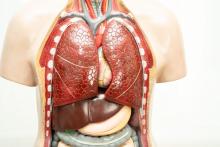Recent Publications

Changes in long-term employment and income following COVID-19 (SARS-CoV-2) infection among Jewish and Arab populations in Israel (BMC Public Health .)
The impact of Coronavirus disease-2019 (COVID-19) extends beyond health, potentially affecting long-term income and employment dynamics. In Israel, disparities exist between Jewish and Arab populations across many dimensions, including socioeconomic. The study's primary aim was to compare changes in employment and income among COVID-19-infected and non-infected participants among Jews and Arabs, the two main population groups comprising the population of Israel.
(Haneen Shibli, Paul Kuodi, Amiel Dror, Hiba Zayyad, Ofir Wertheim, Kamal Abu Jabal, Saleh Nazzal, Daniel Glikman, Michael Edelstein)

Orna Schwartz, Maya Azrad, Avi Peretz: In vitro susceptibility of clinical Clostridioides difficile isolates in Israel to metronidazole, vancomycin, fidaxomicin, ridinilazole and ibezapolstat (BMC Gastroenterol .)
Antibiotics are currently the primary treatment of Clostridioides difficile (C. difficile) infection. Yet, due to rapid development of resistance and high recurrences rates, there is an unmet need for new antimicrobials for C. difficile infections. This study assessed the in vitro susceptibility of clinical isolates from Israel to two recently developed antibiotics, ridinilazole (RDZ) and ibezapolstat (IBZ), and to standard-of-care antibiotics.

Tom Liba, Sondos Shalata: Correlation Between Body Mass Index and Immunotherapy Response in Advanced NSCLC (Cancers (Basel) . )
Immune checkpoint inhibitors (ICIs) have revolutionized the management of advanced non-small cell lung cancer (NSCLC). Emerging evidence suggests a potential association between elevated body mass index (BMI) and enhanced ICI efficacy, yet this relationship remains inconclusive and warrants further investigation. This study aims to evaluate the impact of BMI on treatment efficacy and survival outcomes in advanced NSCLC patients treated with first-line ICI therapy.

Khalaf Kridin: Synergistic activity of dispersin B and benzoyl peroxide against Cutibacterium acnes/Staphylococcus epidermidis dual-species biofilms (PLoS One .)
Cutibacterium acnes plays a key role in the development of acne vulgaris, with biofilm formation contributing to its persistence and resistance to antimicrobial treatments. A critical component of C. acnes biofilms is poly-N-acetylglucosamine (PNAG), an exopolysaccharide that facilitates both biofilm stability and biocide resistance. This study evaluated the efficacy of the PNAG-degrading enzyme dispersin B in enhancing the susceptibility of C. acnes biofilms to benzoyl peroxide (BP), a common anti-acne agent.

Wisam Abboud, Amir Mari: Esophageal Intelligence: Implementing Artificial Intelligence Into the Diagnostics of Esophageal Motility and Impedance pH Monitoring (Neurogastroenterol Motil .)
Esophageal motility disorders (EMDs) encompass a range of functional abnormalities, including achalasia, ineffective esophageal motility (IEM), esophagogastric junction outflow obstruction (EGJOO), and distal esophageal spasm (DES). Diagnostic modalities like high-resolution esophageal manometry (HREM), Functional Lumen Imaging Probe (FLIP), and impedance analysis are invaluable but often limited by interpretive variability and the need for expert analysis. Artificial intelligence (AI) has emerged as a transformative tool in addressing these challenges. This manuscript explores the integration of AI in EMD diagnostics, showcasing its ability to enhance diagnostic accuracy, optimize workflows, and standardize interpretation across centers.

Amir Mari: Trainees' Exposure to the Field of Neurogastroenterology and Motility in Internal Medicine and General Surgery Residency Programs (Neurogastroenterol Motil . )
The disorders of neurogastroenterology and motility (NGM) are common, yet studies have shown that medical students have a relative lack of knowledge and confidence in this field, which may lead to poorer patient outcomes. We sought to evaluate whether this is also true of residents during the next stage of medical training.

Fares Kablan: A New Approach for Reconstruction of Severe Horizontal Atrophy of the Posterior Mandible Using "The Honeycomb Technique": A 10-14 Year Follow-Up Retrospective Study (J Clin Med . )
Autogenous bone grafting has long been the standard for augmenting bone prior to implant placement in atrophic ridges. However, innovative techniques are continually sought to enhance outcomes. This study introduces the honeycomb technique for horizontal bone augmentation in edentulous posterior mandibular ridges, presenting the methodology and long-term follow-up results of this novel approach.

Avi Benov: Finger thoracostomy: Significant risks and unproven benefits in prehospital settings (Transfusion .)
Trauma is a leading cause of preventable death, with a significant portion of trauma deaths occurring in the prehospital setting. Interventions such as chest drainage may play a critical role in managing life-threatening conditions but face challenges due to poorly defined indications and reliance on anecdotal evidence rather than rigorous studies. Among chest drainage techniques, finger thoracostomy (FT) is a well-described, but controversial, method for decompressing the pleural cavity in emergencies like tension pneumothorax or hemothorax. Despite its simplicity and minimal equipment requirements, FT carries risks, including bleeding, infection, organ injury, temporary effects, and procedural failure. This study examines eight FT procedures performed by Israel Defense Forces providers during the 2023-2024 "Swords of Iron" War in Gaza.

D Krupik: Adverse events among early caregivers' COVID-19 vaccination correlated inversely with intention to vaccinate their children (Vaccine .)
Vaccine hesitancy increased during the COVID-19 pandemic. We evaluated if manifestation of adverse events when caregivers received their vaccine was associated with their willingness to vaccinate their children.

Khalaf Kridin, Keren Lyakhovitsky, Adi Ben Arie: Clarifying the association between bullous pemphigoid and hematologic malignancies: a population-based cohort and case-control study (Arch Dermatol Res)
Bullous pemphigoid (BP) is the most common autoimmune blistering disease, primarily affecting older adults. The disease has a significant comorbidity burden, including associations with neurological, psychiatric, and hematological disorders. However, the potential link between BP and hematologic malignancies (HMs) remains debated, with previous studies yielding conflicting results. Some suggest a bidirectional association, while others report no significant link. To clarify this association, we conducted a large-scale, population-based study using Clalit Health Services (CHS) data (2000–2018).

Karin Ben Zaken, Rivka Bouhnik, Naama Omer, Naamah Bloch, Abraham O Samson: Polyoxometalates bind multiple targets involved in Alzheimer's disease (J Biol Inorg Chem .)
Alzheimer's disease (AD) is a progressive neurodegenerative disorder characterized by brain aggregates of amyloid-β (Aβ) plaques and Tau tangles. Despite extensive research, effective therapy for AD remains elusive. Polyoxometalates (POMs), a class of inorganic compounds with diverse chemical structures and properties, are emerging as potential candidates for AD treatment due to their ability to target key molecular players implicated in disease pathogenesis, such as Aβ, acetylcholinesterase (AChE) and butyryl acetylcholinesterase (BChE). Here, we use molecular docking to predict the binding pose and affinities of POMs to 10 top targets associated with AD.

Boris Fichtman, Amnon Harel: The Effect of glycocholic acid on the growth, membrane permeability, conjugation and antibiotic susceptibility of Enterobacteriaceae (Front Cell Infect Microbiol . )
Glycocholic acid (GCA) is a steroid acid and one of the main glycine-conjugated bile components in mammalian bile, which is involved in the emulsification and absorption of fats and sterols. It is long-known that the amphipathic nature of bile acids enables them to interact with the lipid membrane of Gram-positive bacteria and act as potent antimicrobial compounds. Nevertheless, Gram-negative Enterobacteriaceae species inhabiting the intestinal tract of mammals are considered to be more bile-resistant compared to Gram-positive bacteria and are thought to tolerate high bile concentrations.

Avi Benov: Blast injury and chronic psychiatric disability in military personnel: Exploring the association beyond posttraumatic stress disorder (J Psychiatr Res .)
Blast injuries are common among military personnel, yet their long-term psychiatric consequences, beyond posttraumatic stress disorder (PTSD) and traumatic brain injury (TBI), remain underexplored. This study investigates the association between blast injuries and non-PTSD psychiatric conditions, including psychotic, neurocognitive, mood, anxiety, adjustment and personality disorders resulting in functional impairment.

Shoshana R Rath: Metabolic syndrome in childhood, adolescent, and young adult cancer survivors: recommendations for surveillance from the International Late Effects of Childhood Cancer Guideline Harmonization Group (Eur J Endocrinol .)
Survivors of childhood, adolescent, and young adult (CAYA) cancer have an increased risk of metabolic syndrome (MetS). MetS describes the clustering of cardiovascular risk factors including overweight or obesity, hypertension, impaired glucose tolerance, and hyperlipidaemia. While associated cardiovascular sequelae can be serious, MetS is preventable, manageable and potentially reversible with the appropriate pharmacological and/or behavioral interventions. To optimise health outcomes in CAYA cancer survivors, international, harmonised surveillance recommendations are essential.




